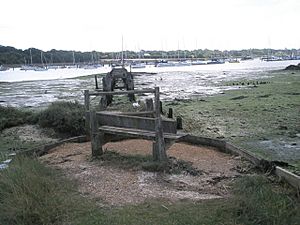Mercury Marshes facts for kids
Quick facts for kids Mercury Marshes |
|
|---|---|
 |
|
| Type | Local Nature Reserve |
| Location | Hamble-le-Rice, Hampshire |
| OS grid | SU 486 076 |
| Area | 6.4 hectares (16 acres) |
| Managed by | Hampshire Countryside Service |
Mercury Marshes is a special natural area in Hamble-le-Rice, Hampshire, England. It covers about 6.4 hectares (which is like 15 football fields!). This amazing place is officially a Local Nature Reserve. This means it's protected because it's important for wildlife and for people to enjoy nature.
The land is owned by Hampshire County Council. It is looked after by the Hampshire Countryside Service. Mercury Marshes is also part of even bigger protected areas. These include the Solent and Southampton Water Ramsar site (important wetlands) and Special Protection Area (for birds). It is also part of the Solent Maritime Special Area of Conservation and a Site of Special Scientific Interest. These titles show how valuable this area is for nature.
Contents
What is Mercury Marshes?
Mercury Marshes is located on the west side of the River Hamble. It has many different types of natural environments. You can find muddy areas that are covered by the tide, tall reedbeds, small islands, and areas of saltmarsh. There are also narrow water channels called creeks and some woodland.
Habitats and Plants
The saltmarsh and islands are home to special plants. These plants can live in salty water. Some common ones you might see include sea purslane, cordgrass, sea aster, and glasswort. These plants are very important. They provide food and shelter for many animals.
Wildlife at the Marshes
This nature reserve is a vital home for many creatures. It is especially important for tiny animals without backbones, called invertebrates. These include insects, spiders, and worms. The marshes are also a key spot for waders. These are birds that have long legs and bills. They use them to find food in the mud and shallow water.
Why is Mercury Marshes Important?
Mercury Marshes helps protect many different types of wildlife. It gives them a safe place to live and find food. The different habitats, like the mudflats and saltmarshes, are perfect for many species. Protecting places like this helps keep our natural world healthy. It also allows people to learn about and enjoy nature.
Images for kids


